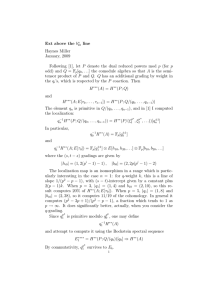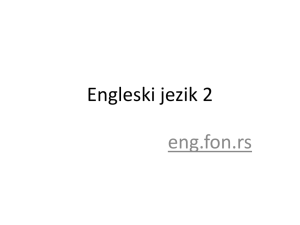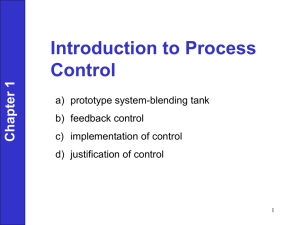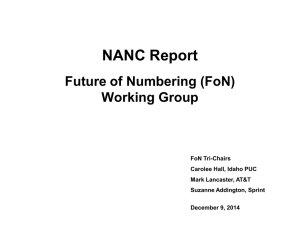Control of the Three Tank System in H /H Space
advertisement
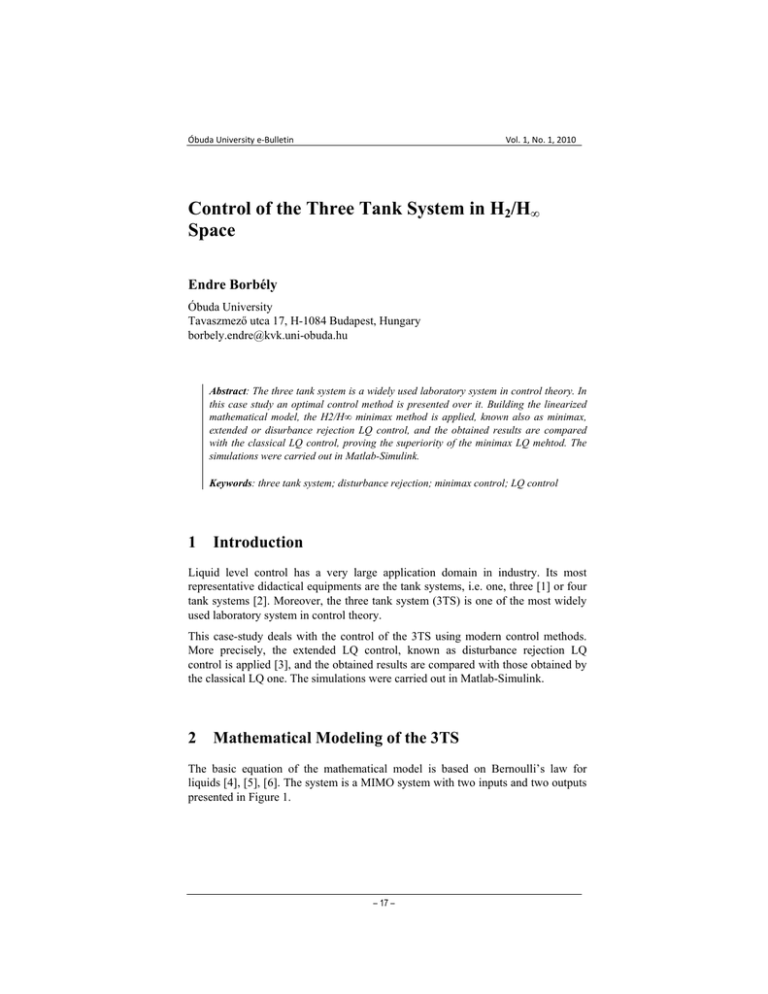
Óbuda University e‐Bulletin Vol. 1, No. 1, 2010 Control of the Three Tank System in H2/H∞ Space Endre Borbély Óbuda University Tavaszmező utca 17, H-1084 Budapest, Hungary borbely.endre@kvk.uni-obuda.hu Abstract: The three tank system is a widely used laboratory system in control theory. In this case study an optimal control method is presented over it. Building the linearized mathematical model, the H2/H∞ minimax method is applied, known also as minimax, extended or disurbance rejection LQ control, and the obtained results are compared with the classical LQ control, proving the superiority of the minimax LQ mehtod. The simulations were carried out in Matlab-Simulink. Keywords: three tank system; disturbance rejection; minimax control; LQ control 1 Introduction Liquid level control has a very large application domain in industry. Its most representative didactical equipments are the tank systems, i.e. one, three [1] or four tank systems [2]. Moreover, the three tank system (3TS) is one of the most widely used laboratory system in control theory. This case-study deals with the control of the 3TS using modern control methods. More precisely, the extended LQ control, known as disturbance rejection LQ control is applied [3], and the obtained results are compared with those obtained by the classical LQ one. The simulations were carried out in Matlab-Simulink. 2 Mathematical Modeling of the 3TS The basic equation of the mathematical model is based on Bernoulli’s law for liquids [4], [5], [6]. The system is a MIMO system with two inputs and two outputs presented in Figure 1. – 17 – E. Borbély Control of the Three Tank System in H2/H∞ Space Figure 1 General model of the 3TS The input voltage signals of the pumps, uc1 and uc2 were considered the inputs of the system, while the liquid levels h1 and h2 the outputs. The disturbances of the system were considered the positions of the valves (0 = closed, 1 = open), namely the valves between the tanks, us13, us32, the nominal outflow valve ug2 and the outflow valve of each tank, ue1, ue2, ue3. The linearized mathematical model given by equations (1)–(5) was obtained from the non-linear model, [4], [5], using linearization over trajectories in the vicinity of stationary variables marked with indices “0”. One can observe the disadvantage of the obtained mathematical model, namely that the equations are modelling correctly the 3TS only when the liquid levels are not the equal. Therefore, the paper discusses only the situation when the liquid levels are different. In the case when the liquid levels are equal, the 3TS becomes a collection of three independent one tank system, due to the fact that they are in equilibrium. 2g dΔh1 . sgn( h10 − h30 ) h10 − h30 .Δu s1 − =− dt A − + − 2g A 2g A 2g A u s10 . sgn( h10 − h30 ) u s10 1 2 h10 − h30 h10 .Δu e1 − 2g A 1 2 h10 − h30 .Δh1 + sgn( h10 − h30 ).Δh3 − u e10 1 2 h10 – 18 – c .Δh1 + 1 .Δu c1 A (1) Óbuda University e‐Bulletin 2g dΔh2 =− dt A A 2g − A 2g − A 2g + A d Δ h3 = dt 2g A 2g + − − + − − A 2g A 2g A 2g A 2g A 2g A h20 .Δu e 2 − 2g + Vol. 1, No. 1, 2010 2g 1 u e 20 A 2 h20 .Δh2 + sgn( h30 − h20 ). h30 − h20 .Δu s 2 − u s 20 . sgn( h30 − h20 ). h20 .Δu g 2 − 2g 1 2 h30 − h20 1 u g 20 A u s 20 . sgn( h30 − h20 ). .Δh2 − (2) .Δh2 + 2 h20 1 2 h30 − h20 c .Δh3 + 2 .Δu c 2 A . sgn( h10 − h30 ) h10 − h30 .Δ u s1 + u s10 . sgn( h10 − h30 ). u s10 . sgn( h10 − h30 ). 1 .Δ h1 − 2 h10 − h30 1 .Δ h3 − 2 h10 − h30 sgn( h30 − h 20 ). h30 − h 20 .Δ u s 2 + u s 20 . sgn( h30 − h 20 ). u s 20 . sgn( h30 − h 20 ). . h30 .Δ u e 3 − 2g A 1 2 h30 − h 20 1 2 h30 − h 20 u e 30 . 1 2 h30 (3) .Δ h 2 − .Δ h3 − .Δ h3 Δy1 = Δh1 (4) Δy2 = Δh2 (5) Comparing the non-linear and linearized system (the steady-state points were selected h10 = 50 cm, h20 = 10 cm, and h30 = 30 cm), the linearized system proved to approximate correctly the non-linear system, [5]. – 19 – E. Borbély 3 Control of the Three Tank System in H2/H∞ Space Minimax Control of the 3TS In this situation the case study was considered with every valve in open position: us13 = us32 = ug2 = ue1 = ue2 = ue3 = 1 (6) The initial liquid levels were the same as before: h10 = 50 cm, h20 = 10 cm, and h30 = 30 cm. The disturbance rejection problem is based on a minimax criteria [1], where the system dynamics is generally described by: x (t ) = Ax(t ) + Bu (t ) + Ld (t ) y (t ) = Cx(t ) (7) Here one can observe that the desired input (control signal, u(t)) is treated separately from the disturbance input d(t). As a result the general B matrix of an LTI system is separated in two: in a new B matrix (for the control signal) and an L matrix (for the disturbance signal). The quadratic cost functional is extended from the classical LQ problem to include the effect of disturbance d(t) explicitly: J( u,d ) = 1∞ T 2 T T ∫ [ y ( t ) y( t ) + u ( t )u( t ) − γ d ( t )d ( t )] dt 20 (8) It can be seen that the R and Q matrix from the classical LQ control description are not appearing now and the weighting is made here by one parameter, γ. (8) reflects that the disturbance attempts to maximize the cost while we want to find a control u(t) that minimizes the maximum cost achivable by the disturbance (by the worst case disturbance). According to [1], the optimal control and the worst case disturbance is given by: u* ( t ) = − BT Px* ( t ) d* ( t ) = 1 γ2 (9) LT Px* ( t ) (10) where P is a positive definite symmetric solution to the modified control algebraic Riccati equation (MCARE): PA + AT P + C T C − P( BB T − 1 γ2 LLT )P = 0 – 20 – (11) Óbuda University e‐Bulletin Vol. 1, No. 1, 2010 To solve the above formulated problem for the 3TS firstly we had to determine with Matlab the optimal γ (γ Є [0,1]). Using γ-iteration it has resulted for the optimal value: γmin=0.0115, [6]. To check the optimality of the obtained result, the disturbance rejection was tested in case of the 3TS for three values of γmin, namely: γ= γmin, γ= 10 γmin, γ= 100 γmin. The resulted solutions of the MCARE are given by Table 1. Table 1 The solutions of MCARE for different γ. γ γmin 10 γmin 100 γmin P -7.6472 13.4040 -0.2914 -.00019 9.2368 0.1387 0.0018 9.0144 0.1332 278.2956 -7.6472 13.6618 9.9723 -0.0019 0.1562 9.5114 0.0018 0.1435 13.6618 -0.2914 1.0330 0.1562 0.1387 0.0562 0.1435 0.1332 0.0529 In the same time a classical LQ design was made too (without γ), [6]. The obtained solution was: ⎛ 9.4641 ⎜ P = ⎜ 0.0021 ⎜ 0.1422 ⎝ 0.0021 0.1422 ⎞ ⎟ 8.9907 0.1327 ⎟ 0.1327 0.0525 ⎟⎠ (12) One can see that this is very similar to the case of disturbance rejection LQ for 100 γmin. The so obtained result demonstrates once again the theory, that for big values of γ, the disturbance rejection LQ method becomes again a classical LQ problem. The illustration of this affirmation is presented applying step disturbances on the 3TS. The change of the liquid level (in meters) was simulated in time (seconds). In Figure 2 the biggest possible change of h2 is presented for each γ-case considered, over each disturbance effect (us13, us32, ug2, ue1, ue2, ue3). It can be seen that for γmin = G = 1 the biggest disturbance can be applied for us13, ue1, ue3 (for Tank 1 and Tank 3). However for us32, ug2, ue2 the effect of the disturbances were minimized on h2, as these values are the characteristic disturbances for Tank 2 (and now the disturbance was considered over h2). More details can be obtained from [6]. – 21 – E. Borbély Control of the Three Tank System in H2/H∞ Space From the first output (h1) point of view, similar results were obtained, but now the disturbances are maximized for us32, ug2, ue2, ue3 and are minimized for us13, ue1 (Figure 4). Figure 3 presents the results of simulating the effect of step disturbance over a classical LQ problem, [6]. It can be seen that the results in Figure 2 (for 100 γmin (G=100)) and Figure 3 are the same. The same conclusion can be seen comparing the results of Figure 4 with Figure 5. Figure 2 Disturbance rejection over h2 for different γ values in time (G-multiple of γmin). Figure 3 Disturbance rejection over h2 in time for classical LQ – 22 – Óbuda University e‐Bulletin Vol. 1, No. 1, 2010 Figure 4 Disturbance rejection over h1 for different γ values in time (G-multiple of γmin) Figure 5 Disturbance rejection over h1 in time for classical LQ Conclusions In this paper the disturbance rejection LQ control was applied on the 3TS and the obtained results were compared with those obtained by the classical LQ method. The superiority of the minimax control was demonstrated, namely that for big weighting values obtained for the worst case disturbance, the disturbance rejection LQ method becomes a classical LQ problem. Acknowledgement This research has been supported by Hungarian National Scientific Research Foundation, Grant No. OTKA T042990 and by Hungarian National Office for Research and Technology (RET-04/2004). – 23 – E. Borbély Control of the Three Tank System in H2/H∞ Space References [1] Skogestad S., I. Postlethwaite: Multivariable Feedback Control, Prentice Hall, New Jersey, 2001 [2] Gatzke E.P., E.S. Meadows, Ch. Wang, F.J. Doyle: Model Based Control of a Four-Tank System, Journal of Computers and Chemical Engineering, 2000, vol. 24/2-7, pp. 1503-1509 [3] Zhou K.: Robust and Optimal Control, Prentice Hall, New Jersey, 1996 [4] DTS200 - Laboratory Setup Three Tank System, Amira GmbH, Duisburg, 2000 [5] L. Kovács: Control of the Three Tank System (3TS). Case study (in Romanian), MSc diploma, University Politechnica of Timisoara, Romania, 2001 [6] L. Kovács: Classical and Modern Multivariable Control Designing Methods of the Three Tank System. Periodica Politechnica, Transactions on Automatic Control and Computer Science, Timisoara, Romania, 2003, Vol. 48/62, pp. 80-86 [7] Levente Kovács, Endre Borbély, Zoltán Benyó: Optimal Control of the Three Tank System in H2/H∞ space SAMI 2010 8th IEEE International Symposium on Applied Machine Intelligence and Informatics January 2830, 2010 Herl'any, Slovakia – 24 –

